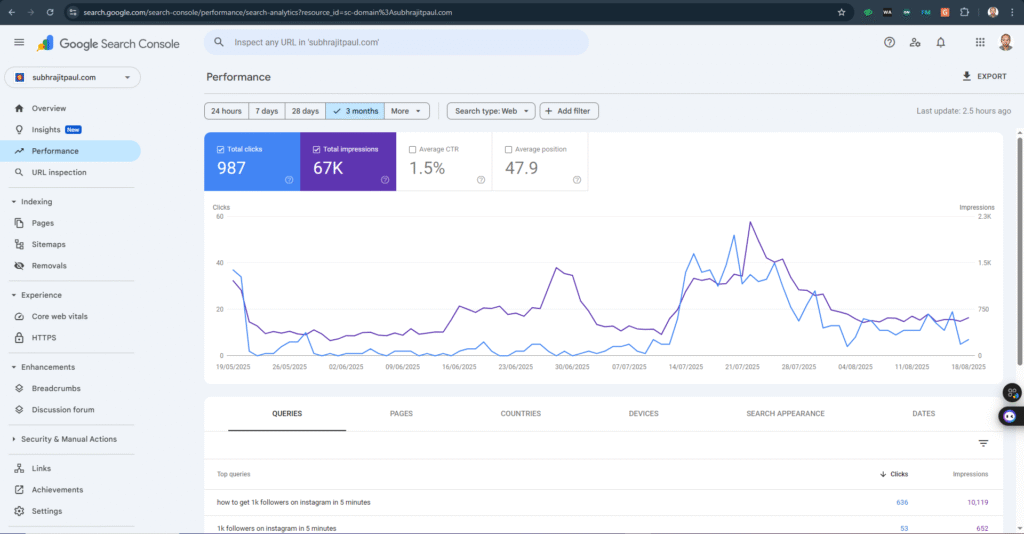
Introduction
To succeed in SEO, you must monitor how your website performs in search. That’s where Google Search Console metrics come in. They provide essential insights into clicks, impressions, CTR, and rankings. By tracking them, you can optimize your site effectively and stay ahead of competitors.
1. Google Search Console Metrics: Total Clicks
The total clicks metric reveals how many users actually visited your website from Google search. Because clicks reflect user interest, monitoring this metric helps you improve page titles and descriptions for better results. The total clicks metric tells you how many users clicked your site’s link in Google search results. This shows how effective your meta titles and descriptions are in attracting visitors. Tracking clicks helps identify which pages are bringing in the most traffic.
2. Google Search Console Metrics: Impressions
Impressions show how often your site appeared in search results. If impressions are high but clicks remain low, your snippets may not be compelling enough. Therefore, improving headlines and meta descriptions is key. Even if users didn’t click, impressions tell you about your visibility. High impressions with low clicks may mean you need better optimization of titles and descriptions.
3. Google Search Console Metrics: Click-Through Rate (CTR)
CTR measures the percentage of impressions that turn into clicks. A low CTR indicates missed opportunities. Moreover, optimizing titles, adding numbers, or using power words can increase this crucial metric. CTR shows the percentage of users who clicked on your site after seeing it. A low CTR signals that your headlines or snippets might not be engaging enough. Improving CTR can directly boost your website traffic.
4. Google Search Console Metrics: Average Position
The average position metric highlights where your page usually ranks in search results. In addition, tracking position changes over time helps you understand whether your SEO strategies are paying off. Monitoring this helps you understand keyword performance. If a page has high impressions but low rankings, you know it needs SEO attention.
5. Index Coverage
Without proper indexing, your pages won’t appear in search. The index coverage report helps identify crawling errors, blocked resources, or pages excluded from Google’s index. Fixing these issues ensures full visibility. Errors in index coverage can block your site from appearing on Google at all. Regularly check for pages with issues like “Crawled – Currently Not Indexed” and fix them promptly to ensure full visibility.
6. Core Web Vitals
Core Web Vitals measure page load speed, responsiveness, and visual stability. Since Google prioritizes user experience, improving these metrics boosts both SEO and customer satisfaction. These metrics directly affect both SEO rankings and user satisfaction. A fast and stable site reduces bounce rates and builds trust.
Conclusion
Monitoring Google Search Console metrics is non-negotiable for SEO success. By focusing on clicks, impressions, CTR, ranking position, and Core Web Vitals, you can identify weaknesses, act quickly, and achieve long-term growth. Google Search Console metrics are more than just numbers—they tell the story of your website’s performance in search. By monitoring clicks, impressions, CTR, position, and Core Web Vitals, you gain the insights needed to refine your SEO strategy and achieve long-term growth. Contact Us for Information.
Or click on Bellow Links
Think with Google – SEO Insights
Google Developers – Core Web Vitals

Hello my loved one I want to say that this post is amazing great written and include almost all significant infos I would like to look extra posts like this
Your writing is like a breath of fresh air in the often stale world of online content. Your unique perspective and engaging style set you apart from the crowd. Thank you for sharing your talents with us.
Your blog is a treasure trove of valuable insights and thought-provoking commentary. Your dedication to your craft is evident in every word you write. Keep up the fantastic work!
Hi my loved one I wish to say that this post is amazing nice written and include approximately all vital infos Id like to peer more posts like this
Your writing has a way of making even the most complex topics accessible and engaging. I’m constantly impressed by your ability to distill complicated concepts into easy-to-understand language.
I simply could not go away your web site prior to suggesting that I really enjoyed the standard info a person supply on your guests Is going to be back incessantly to investigate crosscheck new posts
Your ability to distill complex concepts into digestible nuggets of wisdom is truly remarkable. I always come away from your blog feeling enlightened and inspired. Keep up the phenomenal work!
Your blog is a breath of fresh air in the crowded online space. I appreciate the unique perspective you bring to every topic you cover. Keep up the fantastic work!
Your blog is a treasure trove of knowledge! I’m constantly amazed by the depth of your insights and the clarity of your writing. Keep up the phenomenal work!